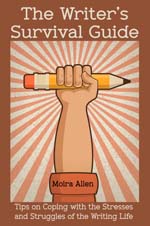 Your Guide to a Successful Writing Career
| |||
|
by Hank Quense Once you publish a book, itís your job as the author to spread the word about the book, to create a buzz about it. This will get some folks interested in or curious about the book, and these folks will visit your selling site. Once they arrive, your pitch message is the key to converting those visitors to buyers. The pitch message tells the world why your book matters and why readers should buy it. This is a vital aspect of self-marketing. Consider this: thousands of new books become available every month. Consequently, your book is competing against all these other books for the readers' attention and money. Your book has to stand out and persuade readers to shell out money to get a copy. Website visitors are capricious and fleeting; they don't act like potential customers in a brick-and-mortar bookstore. Those customers wander around browsing. Website visitors don't. You have a few heartbeats to convince them to stay on the site and read further; that is the job of the pitch message. The good news about the pitch is that unlike many other marketing activities, it's free. It can also be completed before the book is published. I start working on a pitch message for a new book long before the book is finished. This gives me ample time to tinker with the message and to perfect it. There are three elements involved in developing your book's pitch message. First, write a pitch line followed by the answers to two questions. The first question is: What's in it for the buyer? The second is: What's different about this book? Essentially, the process entails developing three sentences or short paragraphs that can be used to sell your book. The pitch line is the hook to grab the readers' attention. Its purpose is to persuade the visitor to read the two statements that follow. The pitch line should be simple, a few sentences at most, and it must make a clear statement about your book. What's in it for the buyers? is an answer that explains what the reader (i.e. a book buyer) will get in exchange for money. This must be explicit. This is not the place to get cute. Don't come across like the legendary used-car salesman. Tell the readers what benefit they'll get from buying the book. Think of the answer in this way: If your book is surrounded by hundreds of other books on a shelf in bookstore, what would persuade the buyer to choose your book instead of one of the others? What's different about this book? You have to respond with a statement about what makes your book stand out from the other books published every month. These dry descriptions are difficult to grasp, so I'll use an example to illustrate the process. Your name is Homer and you're a wandering storyteller in ancient Greece who travels from village to village telling a long tale you composed about a war. You can count on getting free meals and a bed from the villagers, but now you think you're ready for prime time in the major Greek cities. You think long and hard about how to let the big city leaders know about your story and get them interested in hearing it. So, you develop a pitch message to get attention for your story. After the message is finished, you hire runners to deliver it to Athens, Sparta, Thebes, and Corinth. Here is the message: Pitch Line: A wanton queen runs away with a handsome visiting prince and touches off a great war. What's in it for the listener? With graphic descriptions of nasty battles, great heroes, interfering gods and goddesses, the story is the climax of a ten-year war. What's different about this story? The tale demonstrates the superiority of the Greek culture and warriors. Against the greatest power in the Aegean world, the Greek army fights its way to the unconquerable walled city of Troy and is victorious. Do you get the idea? How do you start? Take a blank sheet of paper or a start a new mind-map file on your computer. Jot down every idea that comes to you for each of the three parts. Don't eliminate any ideas because you think they are too dumb. This 'dumb idea' may trigger a great thought or two later on. Keep refining the ideas. Add more ideas, combine others. Eventually, the ideas will get distilled down to a few key thoughts, but it may take more than a single session to get there. The next step is to embed the remaining ideas into sentences for each component of the message. This is another repetitive exercise. Keep writing new sentences, rephrase them, combine them, rearrange them. Over time, your message will evolve and solidify. Once you develop the complete message, don't sit back and relax. You need at least one, preferably two, paraphrases of the message. These are used to repeat the message -- to emphasize it -- without using the same words. What do you do with the message after you develop it? You stick it anywhere it'll fit. On your website, on blogs, in ads, in press releases, in your trailer. If you can't fit the entire message someplace (such as Twitter), use the pitch line by itself. When you use the entire message, don't use the underlined terms in the example above. Just string the sentences together into a paragraph or two. Here are some uses for the differentiation statement. Book Covers: If your book has a print version, the back cover is the ideal place to put your message. If you're like me, when you pick up a new book, you look at the back cover. A great pitch line can make the difference between the customer choosing your book or putting it back on the shelf. Obviously, to get it on the back cover, you'll need to develop the message in advance of submitting the cover. Website Use: On your book-buying website page, make the pitch line the first thing a visitor will see. Follow that with the rest of the pitch statements. Why? Earlier, I mentioned that on the internet, visitors are capricious, with attention spans too minuscule to measure. When these visitors land on your web page, you have a second or two to persuade them to read beyond the first few lines of text they see. That is the job of your pitch line: to get the visitors to read further. The next statement (what's in it for the buyer?) has to tell them there is something of value here, something they can use or enjoy. Finally, you tell them what is different about your book, what is in it that they can't get elsewhere. If this works, the visitors will read even further, to where they can learn how to get a copy and how much it'll cost. If you get a sale, you have accomplished the difficult process of converting a visitor to a customer. Trailer Use: Make sure your message is clearly emphasized in the trailer. Get the message in the beginning and the end of the trailer. Innumerable people from all over the world can view the trailer and you want them to understand your message. When you get a first cut of the trailer, make sure the statements come across. If they don't, tell the trailer company to modify the trailer. Internet Announcements: Log onto social media sites and post an announcement that your book is available. Include the message in the announcement. If space is limited, make sure the pitch line is in the announcement. Join book sites like Goodreads and Librarything. Add information about your book. You can upload the cover and add descriptive text about it. Make sure the text includes your message and place it early in the text. Press Releases: Display your message prominently. Make it the opening statement in the body of the release. Rephrase the message and place it a second time further down in the body. Email: Use the signature capability in your email program to build a unique signature using the pitch line by itself. Link that pitch line to your book-selling website. Now, every time you send an email, you'll also be marketing your book. Bookbuzzr: This is a website that allows you to give potential buyers an opportunity to read a sample of your book. I put these widgets on the buy page for each of my books. If a visitor clicks on the widget, they are shown a "The Story Behind the Book" blurb while the sample loads. This is an ideal spot to put a paraphrased message. It will prime the reader for the sample. It should be a paraphrased version because the reader may have already read the primary statement on your website before clicking on the Bookbuzzr widget. Media Kit: Make sure your media kit includes the message when you describe your book because media types need to be impressed just as website visitors do. Giveaways: Get the statement, or at least the pitch line, on bookmarks and business cards. In conclusion, let me say that once your pitch message is completed, you've taken a big step toward getting people to buy your book. Always look for additional opportunities to display it.
This article is based on material from the author's Marketing Plans for Self-published Books This article is not available for reprint without the author's written permission. Hank Quense writes humorous and satiric scifi and fantasy stories. He also writes about fiction writing and self-publishing. He has published 14 books and 50 short stories along with a few dozen articles. He often lectures on fiction writing and publishing and has a series of guides covering the basics on each subject. He is currently working on a series of four books called Self-publishing Guides: Self-publishing a Book, Marketing Plans for Self-published Books, Manage Your Self-Publishing Project and Business Basics for Authors. He and his wife, Pat, usually vacation in another galaxy or parallel universe. They also time travel occasionally when Hank is searching for new story ideas. |
| ||
| |||




